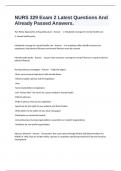NURS 329 Exam 2 Latest Questions And
Already Passed Answers.
Two Policy Approaches to Equalizing Care - Answer 1. Mandated coverage for mental health care
2. Mental health parity
Mandated coverage for mental health care - Answer if an employer offers health insurance for
employees, both physical illnesses and mental illnesses must be covered
Mental health parity - Answer ensures that insurance coverage for mental illnesses is equal to that for
physical illnesses
Nursing Advocacy Strategies - Answer -Fight the stigma
-Share your personal experience with mental illness
-Influence public opinion and the legislature
-Vote
-Send emails/letters to legislators
-Join "Action Alert" list serves for causes related to mental health
-Patient advocacy
-Make in-person visits to your legislators
-Speak out for the rights of your patients and their families
-Write letters to the editor of your local newspaper
-Participate on community boards
-Join professional nursing organizations/ associations or student organizations
-Volunteer for non-profit organizations
Advance Directive - Answer Documents, that came about through Patient Self-Determination Act
(PSDA) of 1990, that are written while a person is competent specifying treatment if person becomes
incompetent
,Schizophrenia Spectrum Disorders - Answer Disorders characterized by psychosis; altered cognition,
altered perceptions, or an impaired ability to determine what is or is not real (an ability that is known as
*reality testing*)
Spectrum includes:
Schizotypal Personality disorder (Delusional disorder)
Brief Psychotic disorder
Schizophreniform disorder
Schizoaffective disorder
Schizophrenia
Domains of Psychotic Disorders per DSM V - Answer Abnormalities in one or more of the following:
- Delusions
- Hallucinations
- Disorganized thinking/speech
- Grossly disorganized or abnormal motor behavior (include catatonia)
- Negative symptoms
Etiology of Psychotic Disorders - Answer Genetic Component
Prenatal and Postnatal Factors
-Environmental triggers of genetic vulnerability
-Link with obstetrical complications (toxemia, preeclampsia, and L&D complications leading to fetal
hypoxia)
-Maternal viral infection (flu & rubella)
-Season of birth theory - increased schizophrenia among winter babies
-Maternal Stress → stress hormones affecting fetal brain development
Post natal brain insult - head injury early childhood (<10 years old) linked to earlier onset
Diathesis-Stress Model of Schizophrenia - Answer
,Schizophrenia Neurobiology - Answer Increased volumes of *lateral ventricles → reduced temporal
lobe* volume, specifically in the hippocampal region
Decreased gray matter volume
Smaller brain
Increased density of dopamine receptors
Reduced neuron density
Brain change found to precede onset
Decreased blood flow to frontal lobes (observed via PET scans): which affects Attention, planning,
decision making
Thalamus smaller and hypoactive: which affects Sensory filtering, information processing
Basal ganglia overactivity: which affects Movement and speech (motor inhibition & planning/learning)
Schizophrenia Neurobiology: Dysregulation hypothesis - Answer Underactive dopamine pathways to
mesocortical areas
-Mesocortical pathway functions in insight, judgment, social consciousness, inhibition, high cognition
activities (reasoning, motivation, planning, decision-making)
-Abnormality (hypoactive) - negative symptoms
Overactive dopamine pathways to mesolimbic areas
-Mesolimbic pathway functions in memory, smell, automatic visceral effects, emotional behavior
-Abnormality (overactive) - positive symptoms
-Imbalance between serotonin and dopamine; effects on glutamate
Schizophrenia DSM-V Diagnosis Criteria - Answer Two (or more) of the following, each present for a
significant portion of the time during a 1-month period (or less if successfully treated). At least one must
be 1, 2, or 3:
1. delusions
2. hallucinations
3. disorganized speech (e.g. frequent derailment or incoherence)
4. grossly disorganized or catatonic behavior
5. negative symptoms (i.e., diminished emotional expression or avolition
, And social dysfunction & major areas of life functioning affected
And other psychotic disorders and physiological effects (substance use/medical condition) are ruled out
Continuous signs for 6 months with at least1 month of symptoms
Psychotic Disorder Positive Symptoms: Hallucinations - Answer Excesses or distortions of normal
functioning
Auditory hallucinations most common (remember overactivity of dopamine pathways in temporal lobe)
-Content may be degrading (calling person worthless), persecutory (saying the doctors are trying to kill
them), or commanding (telling to hurt self or others)
Visual hallucinations can occur - can be frightening distortions
Psychotic Disorder Positive Symptoms: Delusion - Answer fixed false and strong held beliefs that do not
change despite evidence to the contrary
Types: grandiose, persecutory/paranoid, somatic, referential, erotomanic, jealous, mixed
Psychotic Disorder Positive Symptoms: Disorganized thinking and speech - Answer poverty of thought,
poor problem solving/decision making, & illogical thinking
-Reflection of altered thought process
-Presents as patient behaving carelessly or trivially, may present as being agitated
-Word salad, incoherence, derailment, illogicality, loose associations, tangentiality, circumstantiality,
pressured speech
Psychotic Disorder Positive Symptoms: Bizarre behavior - Answer grossly disorganized or catatonic
behavior
Catatonia, movement disorders, deterioration of social behavior, inappropriate affect for situation
Psychotic Disorder Consideration - Answer Normalcy of perceptions, thought content and thought
process are very culture-bound, so use caution in discussion of:
God and Religion




